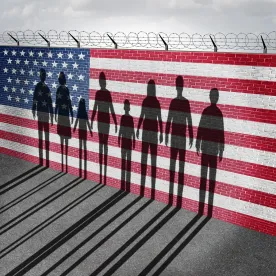With the stroke of a pen, President Biden immediately commenced the deconstruction of the Southern Border wall and several other immigration policies of the prior administration, including the pre-Covid travel bans. Here is a summary of the President’s immigration-related executive actions issued during his first days in office.
Revoking the Pre-Covid Travel Bans
Entitled Presidential Proclamation on Ending Discriminatory Bans on Entry to the United States, this proclamation revokes Executive Order 13780 of March 6, 2017; Proclamation 9645 of September 24, 2017; Proclamation 9723 of April 10, 2018; and Proclamation 9983 of January 31, 2020, the so-called “Muslim Travel Bans” which collectively banned certain nationals of Burma (Myanmar), Chad, Eritrea, Iran, Kyrgyzstan, Libya, Nigeria, North Korea, Somalia, Sudan, Syria, Tanzania, Venezuela, and Yemen from traveling or immigrating to the United States. The proclamation directs the Secretary of State, within 45 days, to deliver plans for expeditiously adjudicating any pending visa applications and re-adjudicating applications previously denied pursuant to the travel bans. In addition, the proclamation calls for the Secretaries of Homeland Security and State, in consultation with the Director of National Intelligence, within 120 days, to review current screening and vetting procedures for immigrant and nonimmigrant entries, including the use of social media identifiers, and provide recommendations to improve screening and vetting processes.
Covid-Related Travel Restrictions Enhanced
Novel Coronavirus travel restrictions remain
The Presidential Proclamations on Novel Coronavirus restricting the entry of certain individuals traveling from China, Iran, the European Schengen Area, the United Kingdom, Ireland, and Brazil remain in effect until revoked by Presidential action. The State Department’s previously posted guidance for National Interest Exceptions for travelers from the Schengen Area, United Kingdom, and Ireland remain in effect.
COVID Testing Requirements for All Arriving International Travelers
Effective January 26, 2021, the Centers for Disease Control and Prevention (CDC) will require all air passengers entering the United States (including U.S. citizens and Lawful Permanent Residents) to present a negative COVID-19 test, taken within three calendar days of departure, or proof of recovery from the virus within the last 90 days. The new requirements expand on a similar order issued in December requiring testing for travel from the United Kingdom.
Furthermore, the International Travel section of Executive Order on Promoting COVID-19 Safety in Domestic and International Travel details new policy directives impacting international travel including:
-
Requiring travelers seeking to enter the United States from a foreign country to produce proof of a recent negative COVID-19 test prior to entry and complying with other applicable CDC guidelines concerning international travel, including recommended periods of self-quarantine or self-isolation after entry into the United States;
-
Assess the CDC’s order implementing COVID testing requirements to determine if regulations are needed to address: the timing and types of COVID-19 tests; methods of providing of test results; feasibility of implementing protective public health measures, such as testing, self-quarantine, and self-isolation on arrival for travelers entering the United States from countries where COVID-19 tests are inaccessible, particularly where such inaccessibility of tests would affect the ability of United States citizens and lawful permanent residents to return to the United States; and measures to prevent fraud;
-
Provide plans to implement compliance with CDC-recommended periods of self-quarantine or self-isolation for arriving international travelers consistent with applicable law;
-
Directs various US agencies to coordinate with foreign governments and international organizations to establish guidelines for public health measures (including quarantine, testing, COVID-19 vaccination, follow-up testing and symptom-monitoring, air filtration requirements, environmental decontamination standards, and contact tracing) associated with safe international travel. Also directs an assessment of the feasibility of linking COVID-19 vaccination to International Certificates of Vaccination or Prophylaxis (ICVP) and producing electronic versions of ICVPs; and
-
With regard to the sea ports of entry and land borders with Canada and Mexico, directs US agencies to immediately coordinate with the Canadian and Mexican governments regarding public health protocols for land ports of entry and then submit a plan to the President regarding implementation of such health measures at the ports of entry.
Putting the Brakes on DHS and DOL Rules Altering the H-1B Process and Prevailing Wage Levels
White House Chief of Staff Ron Klain issued a memorandum regarding review of pending regulatory actions which directs 1) all rules pending and not yet published in the Federal Register must be immediately withdrawn and 2) agencies must “consider” postponing for 60 days the effective dates for regulations that have been published, but not yet in effect. As a result, the modified version of the Department of Homeland Security’s (DHS) Strengthening the H-1B Nonimmigrant Visa Classification Program Final Rule (H-1B Rule) sent to the Federal Register on January 15, but not yet published, will be withdrawn. In addition, implementation of the Department of Labor’s (DOL) Restructuring of H-1B/H-1B1/E-3 and PERM Wage Levels Rule (Wage Rule) and DHS’ Final Rule, entitled Modification of Registration Requirement for Petitioners Seeking To File Cap-Subject H-1B Petitions (H-1B Registration Rule) will be delayed. See our prior posts summarizing the H-1B and Wage Rules and the H-1B Registration Rule.
Not another Brick in the Wall
In the Proclamation on the Termination Of Emergency With Respect To The Southern Border Of The United States And Redirection Of Funds Diverted To Border Wall Construction, President Biden terminates the prior Trump proclamations declaring a national emergency at the southern border. As a result, all construction and related allocation of funds for the southern border wall are halted while plans are drawn up to redirect funding and repurpose the related contracts.
Additional Executive Orders and Agency Directives
-
Interior Enforcement: Executive Order on the Revision of Civil Immigration Enforcement Policies and Priorities revoking previous Executive Order 13768 of January 25, 2017, (Enhancing Public Safety in the Interior of the United States), and directing the Secretary of State, the Attorney General, the DHS Secretary, and other government officials to review any agency actions developed pursuant to Executive Order 13768 and to take action, including issuing revised guidance, as appropriate and consistent with applicable law. In compliance, the DHS Secretary issued a memorandum directing DHS components to conduct a review of immigration enforcement policies and pausing removal and deportation of certain noncitizens for 100 days.
-
DACA: Presidential memorandum directing the DHS Secretary, in consultation with the Attorney General, to take all actions he deems appropriate, consistent with applicable law, to preserve and fortify Deferred Action for Childhood Arrivals (DACA).
-
DED for Liberians: Presidential memorandum, Reinstating Deferred Enforced Departure (DED) for Liberians through June 30, 2022, staying the removal of any Liberian national who is present in the United States and who was under a grant of DED as of January 10, 2021, with certain exceptions.
-
Census: Executive Order rescinding a prior Trump administration Order and Memorandum that sought to limit counting of the U.S. undocumented population in the national census. President Biden’s Order seeks to ensure that federal funds and congressional apportionment are distributed “without regard to immigration status.”
Proposed Legislation: U.S. Citizenship Act of 2021
On its first day, the Biden Administration also unveiled the outline of a comprehensive immigration reform bill entitled the U.S. Citizenship Act (USCA) of 2021. Among its main goals, the USCA would: (1) provide pathways to citizenship and strengthen labor protections; (2) prioritize smart border controls; and (3) address root causes of migration.
The USCA’s most progressive and controversial provision is its eight-year path to citizenship for most undocumented foreign nationals already in the U.S. as of January 1, 2021. Most applicants would first register for a five-year period of temporary legal status, followed by a three-year lawful permanent residency (aka green card) status. At the end of the combined eight-year period, applicants could apply for U.S. naturalization. Eligible Dreamers, TPS holders, and immigrant farmworkers would be permitted to skip the five-year first step and move straight to applying for lawful permanent residency/green card status. All applicants would be required to pass stringent criminal and national security background checks and pay U.S. taxes.
The USCA also promotes improved case processing, family reunification, and asylum/refugee programs. For example, it seeks to clear green card backlogs, shorten application wait times, and raise per-country visa limitations, depending on the applicant’s category. The bill would also increase green cards available under the Diversity Visa program from 55,000 to 80,000 and make it easier to for foreign graduates of American universities, especially STEM graduates, to remain in the U.S. It also protects families of H-1B visa holders and provides additional rights for certain other visa holders. It would remove asylum restrictions and fund reduction of application backlogs in asylum cases and immigration courts while also funding school districts that accept unaccompanied immigrant children.
The USCA also includes significant enforcement provisions, emphasizing smart border technology and working with border communities. It would require DHS to investigate its “use of force” policies and fund development of improved standards for the care of immigrant individuals and families. The legislation would also expand the ability to prosecute smuggling, trafficking, and other illegal activities, and require US agencies to suppress gang activity in Central America.
Finally, the USCA seeks to shrink future undocumented entrants by reducing migration “push factors” with assistance funds to Central American countries with the expectation that any country accepting assistance will work to curb violence and poverty at home. The Biden Administration has stated publicly that it is unlikely that the USCA will be enacted in its current form; viewing it more as a positioning document to lay out the new president’s immigration goals. It does hope, however, that some provisions will become separate legislation and will likely seek to move some of the USCA’s provisions through Executive action.
This is only the beginning. During the coming days and weeks, we expect to see several changes to Immigration policies and practices by the new administration.





 />i
/>i

